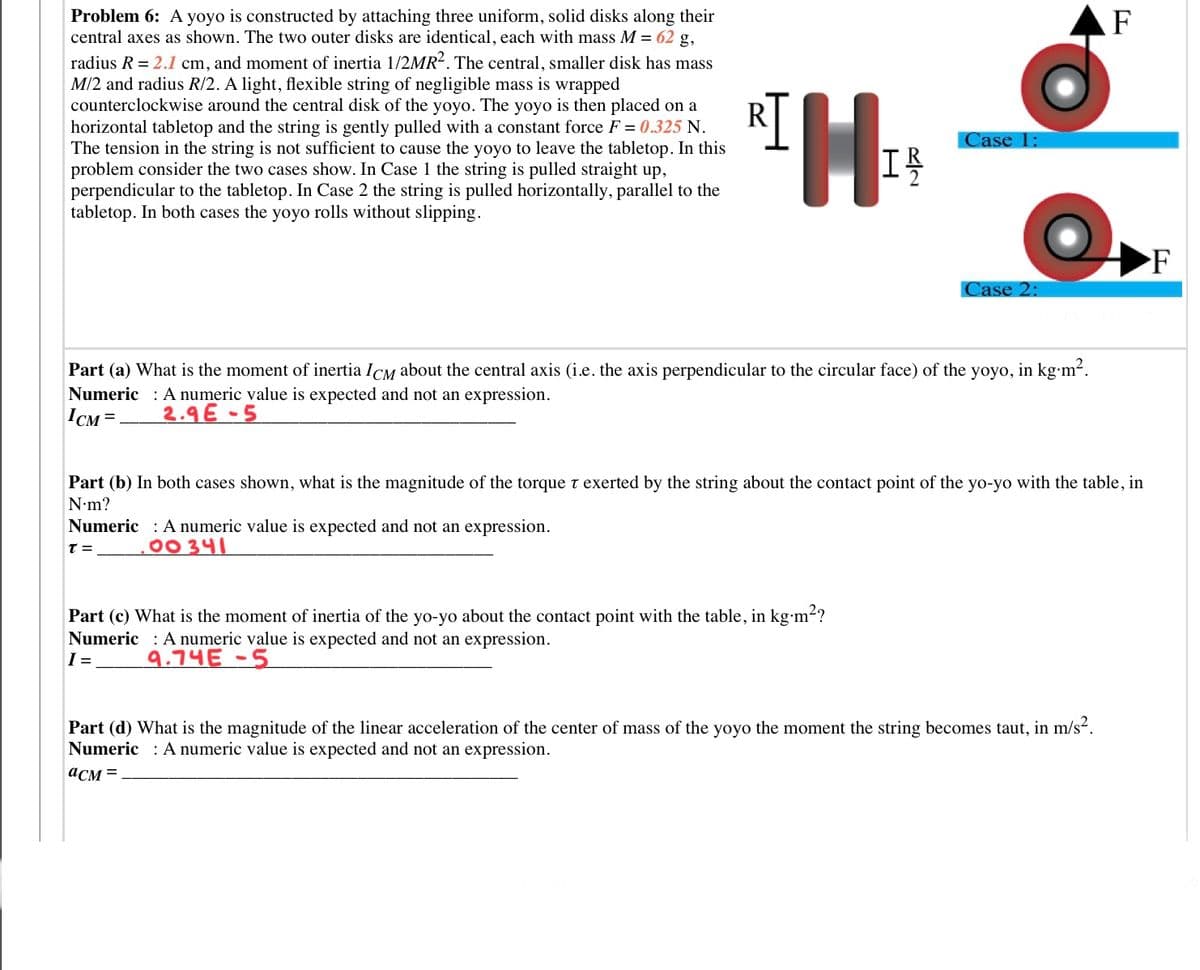Problem 6: A yoyo is constructed by attaching three uniform, solid disks along their central axes as shown. The two outer disks are identical, each with mass M = 62 g, radius R = 2.1 cm, and moment of inertia 1/2MR. The central, smaller disk has mass M/2 and radius R/2. A light, flexible string of negligible mass is wrapped counterclockwise around the central disk of the yoyo. The yoyo is then placed on a horizontal tabletop and the string is gently pulled with a constant force F = 0.325 N. The tension in the string is not sufficient to cause the yoyo to leave the tabletop. In this problem consider the two cases show. In Case 1 the string is pulled straight up, perpendicular to the tabletop. In Case 2 the string is pulled horizontally, parallel to the IN I tabletop In both cases the vovo rolls without slipping
Problem 6: A yoyo is constructed by attaching three uniform, solid disks along their central axes as shown. The two outer disks are identical, each with mass M = 62 g, radius R = 2.1 cm, and moment of inertia 1/2MR. The central, smaller disk has mass M/2 and radius R/2. A light, flexible string of negligible mass is wrapped counterclockwise around the central disk of the yoyo. The yoyo is then placed on a horizontal tabletop and the string is gently pulled with a constant force F = 0.325 N. The tension in the string is not sufficient to cause the yoyo to leave the tabletop. In this problem consider the two cases show. In Case 1 the string is pulled straight up, perpendicular to the tabletop. In Case 2 the string is pulled horizontally, parallel to the IN I tabletop In both cases the vovo rolls without slipping
Physics for Scientists and Engineers, Technology Update (No access codes included)
9th Edition
ISBN:9781305116399
Author:Raymond A. Serway, John W. Jewett
Publisher:Raymond A. Serway, John W. Jewett
Chapter11: Angular Momentum
Section: Chapter Questions
Problem 11.29P: A space station is coast me ted in the shape of a hollow ring of mass 5.00 104 kg. Members of the...
Related questions
Question
8.6 please answer part d, other parts are answered

Transcribed Image Text:Problem 6: A yoyo is constructed by attaching three uniform, solid disks along their
central axes as shown. The two outer disks are identical, each with mass M = 62 g,
F
radius R = 2.1 cm, and moment of inertia 1/2MR². The central, smaller disk has mass
M/2 and radius R/2. A light, flexible string of negligible mass is wrapped
counterclockwise around the central disk of the yoyo. The yoyo is then placed on a
horizontal tabletop and the string is gently pulled with a constant force F = 0.325 N.
The tension in the string is not sufficient to cause the yoyo to leave the tabletop. In this
problem consider the two cases show. In Case 1 the string is pulled straight up,
perpendicular to the tabletop. In Case 2 the string is pulled horizontally, parallel to the
tabletop. In both cases the yoyo rolls without slipping.
RĪ
Case 1:
I
F
Case 2:
Part (a) What is the moment of inertia ICM about the central axis (i.e. the axis perpendicular to the circular face) of the yoyo, in kg-m².
Numeric : A numeric value is expected and not an expression.
ICM =
2.9 E -5
Part (b) In both cases shown, what is the magnitude of the torque t exerted by the string about the contact point of the yo-yo with the table, in
N•m?
Numeric : A numeric value is expected and not an expression.
T =
00 341
Part (c) What is the moment of inertia of the yo-yo about the contact point with the table, in kg•m2?
Numeric : A numeric value is expected and not an expression.
I =
9.74E -5
Part (d) What is the magnitude of the linear acceleration of the center of mass of the yoyo the moment the string becomes taut, in m/s?.
Numeric : A numeric value is expected and not an expression.
асм —
Expert Solution
This question has been solved!
Explore an expertly crafted, step-by-step solution for a thorough understanding of key concepts.
This is a popular solution!
Trending now
This is a popular solution!
Step by step
Solved in 3 steps

Knowledge Booster
Learn more about
Need a deep-dive on the concept behind this application? Look no further. Learn more about this topic, physics and related others by exploring similar questions and additional content below.Recommended textbooks for you

Physics for Scientists and Engineers, Technology …
Physics
ISBN:
9781305116399
Author:
Raymond A. Serway, John W. Jewett
Publisher:
Cengage Learning

Principles of Physics: A Calculus-Based Text
Physics
ISBN:
9781133104261
Author:
Raymond A. Serway, John W. Jewett
Publisher:
Cengage Learning

Physics for Scientists and Engineers: Foundations…
Physics
ISBN:
9781133939146
Author:
Katz, Debora M.
Publisher:
Cengage Learning

Physics for Scientists and Engineers, Technology …
Physics
ISBN:
9781305116399
Author:
Raymond A. Serway, John W. Jewett
Publisher:
Cengage Learning

Principles of Physics: A Calculus-Based Text
Physics
ISBN:
9781133104261
Author:
Raymond A. Serway, John W. Jewett
Publisher:
Cengage Learning

Physics for Scientists and Engineers: Foundations…
Physics
ISBN:
9781133939146
Author:
Katz, Debora M.
Publisher:
Cengage Learning

Glencoe Physics: Principles and Problems, Student…
Physics
ISBN:
9780078807213
Author:
Paul W. Zitzewitz
Publisher:
Glencoe/McGraw-Hill

College Physics
Physics
ISBN:
9781285737027
Author:
Raymond A. Serway, Chris Vuille
Publisher:
Cengage Learning

College Physics
Physics
ISBN:
9781305952300
Author:
Raymond A. Serway, Chris Vuille
Publisher:
Cengage Learning